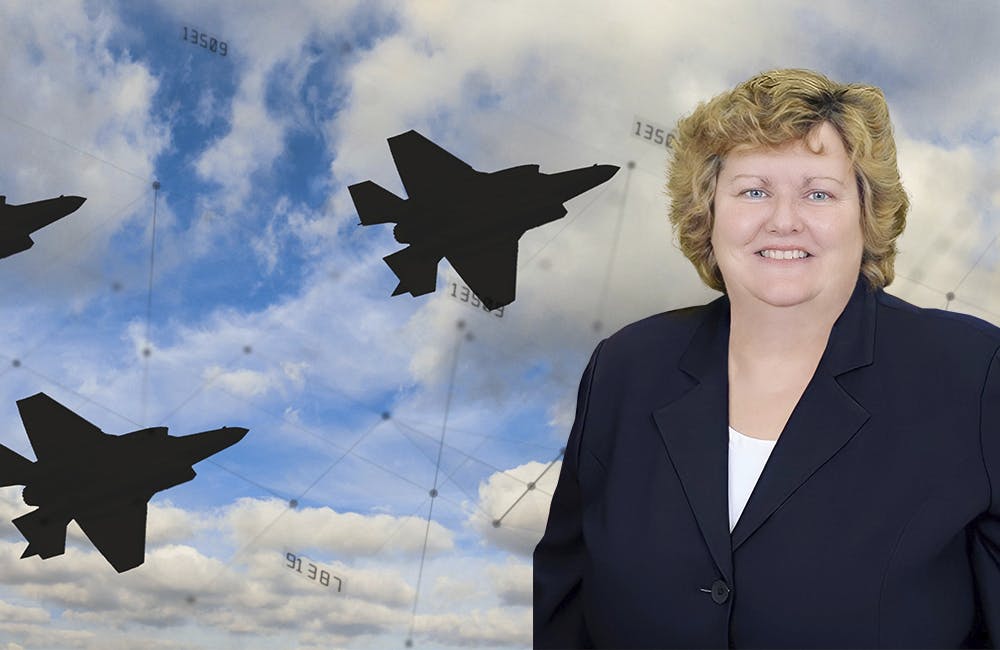Air Force AI Leader Eileen Vidrine is ‘Laser-Focused’ on Fueling Innovation
The data chief returns to the Air Force focused on data preparation to enable AI across the service.

Eileen Vidrine has always “focused on performance optimization” and emerging technology, which helped position her to be the Department of Air Force’s new chief data and artificial intelligence officer (CDAO) this year.
Vidrine, who started her career as an enlisted soldier in the U.S. Army and was commissioned as a transportation officer, has always pursued emerging technology and innovation.
“I look back … even as a transportation platoon officer, I was looking at how many miles … I got on a tire, how to operationalize and work smarter. I would say condition-based maintenance was definitely part of my journey as a transportation logistics officer, but tech enabled me to work smarter,” Vidrine said in an interview with GovCIO Media & Research.
Throughout her career, Vidrine supported the Office of the Director of National Intelligence (ODNI) and the Office of the Under Secretary of Defense for Intelligence and was subsequently selected to serve as a White House Leadership Fellow, where she had the opportunity to support the Office of Management and Budget and the Office of Personnel Management.
Dedicating a significant portion of her career to federal service, Vidrine is also well acquainted with the Air Force. She became the service’s first full-time civilian chief data officer and was deeply involved in developing and implementing the enterprise data management strategy. Now, as the service’s CDAO, she and her team are focused on developing strategies to manage data and AI more efficiently across all mission areas.
“Our team is really empowered to posture the Department of the Air Force with the ability to harness the power of data for mission success and competitive military advantage,” Vidrine said. “In January 2022, our team integrated AI into our portfolio to fully leverage the broad and diverse capabilities.”
The Air Force set a goal to be “AI ready” by 2025 and “AI competitive” by 2027, an aim informed by the congressionally mandated National Security Commission on AI report, which recommended a common digital infrastructure, more agile acquisition and oversight processes, and education for warfighters to reach digital literacy.
“But when I look at it … it is really about providing our workforce — military, civilian, Active Guard Reserve — with the AI infrastructure, the workforce development, the responsible AI policies that will enable innovative organizations to develop AI tools and … solve operational challenges,” Vidrine said. “AI readiness is about setting the enterprise conditions for successful AI for all of our workforce to leverage at the speed of mission.”
To achieve the goal of being “AI ready” by 2025, the service’s Chief Data and AI Office first set up an innovation lab located at Andrews Air Force Base in Maryland, where any airman or guardian is able to leverage the available capabilities.
The office attempts to start small and scale out the opportunity. To date, it has completed over 100 use cases across the spectrum, including condition-based maintenance, personnel, intelligence, surveillance and reconnaissance.
“It’s really our airmen coming from the field and saying, ‘I have this challenge, let’s work on it together,'” Vidrine said. “I always like to say data and AI are team sports because it’s really about taking … the digital experts and partnering them with the functional experts because that helps us maintain the context of the data so that we can really come to solutions together.”
Another core capability the office implemented early on was the program where they brought the citizen airmen, reservists and National Guard personnel back on active duty for up to 12 months at a time, putting them in ‘centers of gravity’ where they were able to coach and mentor the Air Force citizen coders and airmen on active duty.
“Bringing that what I would say industry capability back on to active duty and to coach our … really amazing talent up to tackle them together, so it really helped to grow our acumen and our workforce on tactical solutions,” Vidrine said.
Last week, the Air Force and MIT’s Artificial Intelligence Accelerator finished the CogPilot Data Challenge 2.0, which explored AI research to support and optimize pilot training.
Optimizing pilot training is a big investment for the service and a core area where it continues optimizing performance with AI.
“It’s always fun to have a little bit of a competition, and it’s amazing the diversity of thought that these challenges bring in because you’re bringing in not just uniformed personnel, but industry and academia to be part of the solution,” Vidrine said.
Some of the challenges faced by the office, as well as the Defense Department (DOD) at large, include data sharing at the speed of mission relevency
“We are being very proactive in terms of making sure data sharing is at the speed of mission, and we have made significant progress in that field. Showing that all of these pipelines actually aren’t just notional but actually exist, but that is an area that we are continuing to mature because there’s always an opportunity to improve,” Vidrine said.
The Air Force’s largest investment is in its people to build the data talent pipeline and allow leaders to emerge and improve their skill set, Vidrine added.
The service stood up intern programs along with college transition programs for data and AI. Airmen can major and minor in data science at the Air Force Academy and they are able to go in all mission areas in both air and space.
The service also invests in upskilling people throughout their careers to ensure that strategic leaders are well-versed in this capability.
“Early in the standup of our organization, we recognized that it wasn’t just about building technical capability, but building that workforce piece. And if we go back to being AI-ready in 2025, the talent piece is critical,” Vidrine said.
Vidrine’s team is almost a startup in a mature military department, but it is essential to the service’s overall success.
“But today, we are seeing … that data and artificial intelligence is rapidly becoming part of every airman and guardian’s core DNA,” Eileen Vidrine said. “Because whether we’re talking about strategic-level decisions or tactical decisions, we’re looking at data to drive insight to decision-making at all levels of our department, and that is really true cultural change.”
This is a carousel with manually rotating slides. Use Next and Previous buttons to navigate or jump to a slide with the slide dots
-

Modernizing Critical Infrastructure in the Face of Global Threats
Officials are expanding the latest strategies in boosting defense infrastructure, including securing satellite communications, upgrading enterprise-wide technology, optimizing data management.
28m watch -

Marine Corps Embraces AI for Battlefield Edge in New Implementation Plan
Inaugural implementation plan prioritizes workforce modernization, ethical governance and strategic partnerships to empower Marines.
3m read -

Feds Turn to DevSecOps to Balance Innovation with Public Trust
Officials embrace DevSecOps and a human-centered approach to modernize operations and manage risk as AI becomes more embedded in government.
4m read -

NIH Advances AI Use with Agentic Tools to Boost Health Research
NIH is exploring new agentic AI tools to improve research as the agency builds out its first AI strategic plan.
3m read








